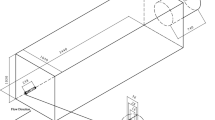Abstract
Oxy-fuel combustion exhibits combustion and heat transfer characteristics different from air-fuel combustion due to high concentrations of CO2 and H2O. This study evaluated the effect of gas and particle emissions on radiative heat transfer in oxy-fuel combustion of coal. For a hexahedral furnace, prescribed gas compositions based on combustion calculation were used to simplify the combustion reactions. The values of radiative heat fluxes (qrad) were compared for different combustion modes, flue gas recirculation (FGR) methods, particle concentrations, furnace sizes and O2 concentrations in the oxidizer. The radiation was calculated by the discrete ordinate method with gaseous emission predicted by the weighted sum of gray gases models (WSGGMs). The results showed that employing an optimized WSGGM is essential for the accurate prediction of qrad in oxy-fuel combustion for gaseous fuels. The conventional WSGGM showed large errors for larger furnace volumes or under dry FGR conditions. With higher particle concentrations such as in pulverized coal combustion, however, qrad was dominated by emission of particles. The effect of gas emissivity was not critical in the furnace with a mean beam length of 8.3m. Oxy-fuel combustion with wet FGR had higher qrad than dry FGR. The O2 concentration in the oxidizer was a key parameter for oxy-fuel combustion since increasing its value linearly increased qrad.
Similar content being viewed by others
References
B. J. P. Buhre, L. K. Elliott, C. D. Sheng, R. P. Gupta and T. F. Wall, Oxy-fuel combustion technology for coal-fired power generation, Prog. Energy Comb. Sci., 31 (2005) 283–307.
T. Wall, Y. Liu, C. Spero, L. Elliott, S. Khare and R. Rathnam et al., An overview on oxyfuel coal combustion — State of the art research and technology development, Chem. Eng. Res. Des., 87 (2009) 1003–1016.
S. P. Khare, T. F. Wall, A. Z. Farida, Y. Liu, B. Moghtaderi and R. P. Gupta, Factors influencing the ignition of flames from air-fired swirl pf burners retrofitted to oxy-fuel, Fuel, 87 (2008) 1042–1049.
S. Hjärtstam, K. Andersson, F. Johnsson and B. Leckner, Combustion characteristics of lignite-fired oxy-fuel flames, Fuel, 88 (2009) 2216–2224.
R. K. Rathnam, L. K. Elliott, T. F. Wall, Y. Liu and B. Moghtaderi, Differences in reactivity of pulverised coal in air (O2/N2) and oxy-fuel (O2/CO2) conditions, Fuel Processing Tech., 90 (2009) 797–802.
H. Cao, S. Sun, Y. Liu and T. F. Wall, Computational fluid dynamics modeling of NOx reduction mechanism in oxyfuel combustion, Energy Fuels, 24 (2010) 131–135.
S. A. Skeen, M. K. Benjamin and R. L. Axelbaum, Nitric oxide emissions during coal and coal/biomass combustion under air-fired and oxy-fuel conditions, Energy Fuels, 24 (2010) 4144–4152.
S. I. Keel, J. H. Yun and S. A. Roh, Behavior of SO 3 in oxy-PC combustion field, Int. Symp. on Low Carbon & Renewable Energy Technology, Jeju, Korea, Nov. 15–18, 2010.
R. Johansson, K. Andersson, B. Leckner and H. Thunman, Models for gaseous radiative heat transfer applied to oxyfuel conditions in boilers, Int. J. Heat Mass Transfer, 53 (2010) 220–230.
C. Yin, L. C. R. Johansen, L. A. Rosendahl and S. K. Kær, New weighted sum of gray gases model applicable to computational fluid dynamics (CFD) modeling of oxy-fuel combustion: derivation, validation, and implementation, Energy Fuels, 24 (2010) 6274–6282.
K. Andersson, R. Johansson, F. Johnsson and B. Leckner, Radiation intensity of propane-fired oxy-fuel flames: implications for soot formation, Energy Fuels, 22 (2008) 1535–1541.
G. Krishnamoorthy, M. Sami, S. Orsino, A. Perera, M. Shahnam and E. D. Huckaby, Radiation modeling in oxyfuel combustion scenarios, Int. J. Comp. Fluid Dynamics, 24(3–4) (2010) 69–82.
P. Edge, M. Gharebaghi, R. Irons, R. Porter, R. T. J. Porter, M. Pourkashanian, D. Smith, P. Stephenson and A. Williams, Combustion modelling opportunities and challenges for oxycoal carbon capture technology, Chem. Eng. Res. Des., 89(9) (2011) 1470–1493.
R. Siegel and J. R. Howell, Thermal radiation heat transfer, 3rd ed., Hemisphere Publishing Corporation, Washington, USA (1992).
H. C. Hottel and A. F. Sarofim, Radiative Transfer, McGraw-Hill, New York (1967).
T. F. Smith, Z. F. Shen and J. N. Friedman, Evaluation of coefficients for the weighted sum of gray gases model, J. Heat Transfer, 104 (1982) 602–608.
Fluent Inc., Fluent 6.3 user’s guide, Lebanon, New Hampshire, USA (2006).
A. Willams, M. Pourkashanian and J. M. Jones, Combustion and gasification of coal, Tayor & Francis, New York (2000) 28.
P. Basu, C. Kefa and L. Jestin, Boilers and Burners: Design and Theory, Springer-Verlag, New York, USA (2000) 132.
J. Hong, J.A. Kim, C. Ryu and Y. Kim, Evaluation of operational characteristics in a 500 MWe opposed-fired coal boiler using computational fluid dynamics, Proc. of 43th Symposium of Korea Society of Combustion, Gyeongju, Korea (2011) 447–450.
Author information
Authors and Affiliations
Corresponding author
Additional information
Recommended by Associate Editor Oh Chae Kwon.
Changkook Ryu is an associate professor in School of Mechanical Engineering at Sungkyunkwan University, Korea. He received his Ph.D degree on Mechanical Engineering at Korea Advanced Institute of Science and Technology (KAIST), in 2001. He was a research associate in Department of Chemical and Process Engineering at University of Sheffield, UK from 2002 to 2007. His research interests include energy conversion of biomass, coal and other fuels by combustion, gasification and pyrolysis.
Sanghyun Park received his B.S degree on Mechanical Engineering at Sungkyunkwan University, Korea. He is currently M.S. candidate in SKKU, Korea. His research interests are oxyfuel combustion for CCS and pulverized coal combustion.
Rights and permissions
About this article
Cite this article
Park, S., Kim, J.A., Ryu, C. et al. Effects of gas and particle emissions on wall radiative heat flux in oxy-fuel combustion. J Mech Sci Technol 26, 1633–1641 (2012). https://doi.org/10.1007/s12206-012-0324-8
Received:
Revised:
Accepted:
Published:
Issue Date:
DOI: https://doi.org/10.1007/s12206-012-0324-8




